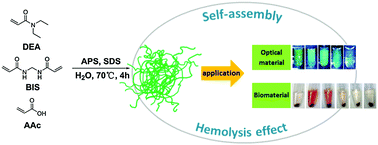Self-assembly and the hemolysis effect of monodisperse N,N-diethylacrylamide/acrylic acid nanogels with high contents of acrylic acid†
Abstract
Monodisperse temperature/pH sensitive poly(N,N-diethylacrylamide/acrylic acid) (P(DEA/AAc)) nanogels with high contents of AAc up to 40 wt% have been prepared. In this study, it was unexpectedly found that the polydispersity of the nanogels with 40 wt% AAc strongly depended on the initiator concentration. Monodisperse P(DEA/AA) nanogels were synthesized only at a very low concentration of initiator. The phase transition behavior of the nanogels in water can be tuned by pH and temperature. Due to low polydispersity, the nanogels self-assembled into colloidal crystals at different temperatures below the volume phase transition temperature (VPTT). The sharp Bragg peaks of the crystals were significantly blue-shifted as the concentration of the nanogels was increased. In contrast, the condensed suspensions without crystals still exhibited clear colours resulting from a short-range order structure. The reflection spectra of the coloured suspensions showed that the peak wavelength became a bit longer and much broader. And the reflection intensity of the coloured suspensions was much weaker. Elastic and coloured crosslinked nanogel networks prepared by a one-pot and rapid light-initiated crosslinking method showed responses to pH and temperature. Furthermore, the interaction between the nanogels and peptide melittin was investigated. The results showed that an increasing AAc composition led to more efficient inhibition of the hemolytic activity of melittin. The nanogels with 40 wt% AAc composition completely inhibited hemolytic activity at a nanogel concentration of 400 µg ml−1. Thus, monodisperse P(DEA/AAc) nanogels of high AAc composition may be developed as efficient substitutes for antibody-based antidotes. Owing to the combined influence of the periodic structure of the crystals of the nanogels and an efficient neutralization effect, the P(DEA/AAc) nanogels show promise to become an integral step for preparing valuable naked-eye biosensors as simple, cheap and stable substitutes for antibody-based antidotes.


 Please wait while we load your content...
Please wait while we load your content...